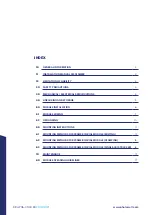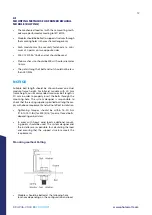
D84-P06-01 GB R3
21/04/2021
www.photowatt.com
10
CORRECT CONNECTION OF PLUG CONNECTORS
•
Make sure that all connections are safe and properly
mated. The PV connectors should not be subjected
to stress from the exterior. Connectors should only
be used to connect the circuit. They should never be
used to turn the circuit on and off.
•
Connectors are not waterproof when unmated.
When installing modules, connectors should be con-
nected to each other as soon as possible or appropri-
ate measures (like using connector endcaps) should
be taken to avoid moisture and dust penetrating into
the connector.
•
Do not clean or precondition the connectors using
lubricants or any unauthorized chemical substances.
USE OF SUITABLE MATERIALS
•
Only use dedicated solar cable and suitable plugs
(wiring should be sheathed in a sunlight-resistant
conduit or, if exposed, should itself be sunlight-re-
sistant) that meet local fire, building and electrical
regulations. Please ensure that all wiring is in perfect
electrical and mechanical condition.
•
Installers may only use single-conductor cable listed
and labeled as USE-2 or PV wire which is 90°C wet
rated in North America, and single conductor cable,
2.5-16 mm² (5-14 AWG), 90°C wet rated in other areas
(i.e. TUV 2PfG1169 or EN 50618 approved), with prop-
er insulation which is able to withstand the maximum
possible system open-circuit voltage. Only copper
conductor material should be used. Select a suitable
conductor gauge to minimize voltage drop and en-
sure that the conductor ampacity complies with local
regulations (i.e. NEC 690.8(D)).
CABLE AND CONNECTOR PROTECTION
•
Secure the cables to the mounting system using
UVresistant cable ties. Protect exposed cables from
damage by taking appropriate precautions (e.g. plac-
ing them inside a metallic raceway like EMT conduit).
Avoid exposure to direct sunlight.
•
A minimum bending radius of 60mm (2.36 in) is re-
quired when securing the junction box cables to the
racking system.
•
Protect exposed connectors from weathering dam-
age by taking appropriate precautions. Avoid expo-
sure to direct sunlight.
•
Do not place connectors in locations where water
could easily accumulate.
5.2
GROUNDING
•
For grounding requirements in North America, a mod-
ule with exposed conductive parts is considered to
comply with UL 1703 only when it is electrically ground-
ed in accordance with both the instructions presented
below and the requirements of the National Electrical
Code. Any grounding means used with Canadian Solar
Inc. modules should be NRTL certified to UL 467 and
UL 2703 standards. Please consult our technical ser-
vice team for the formal approval process.
•
For grounding requirements in other areas, although
the modules are certified to Safety Class II, we rec-
ommend them to be grounded and that module in-
stallation should comply with all applicable local
electrical codes and regulations. Grounding connec-
tions should be installed by a qualified electrician.
Connect module frames together using adequate
grounding cables: we recommend using 4-14 mm²
(AWG 6-12) copper wire. Holes provided for this pur-
pose are identified with a grounding symbol
(IEC61730-1). All conductive connection junctions
must be firmly fixed.
•
Do not drill any extra ground holes for convenience
as this will void the modules warranty.
•
All bolts, nuts, flat washers, lock washers and other
relevant hardware should be made of stainless steel,
unless otherwise specified.
•
EDF ENR PWT does not provide grounding hardware.
•
The grounding method described below is recom-
mended for EDF ENR PWT.




































